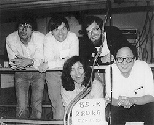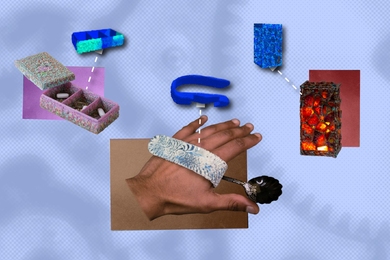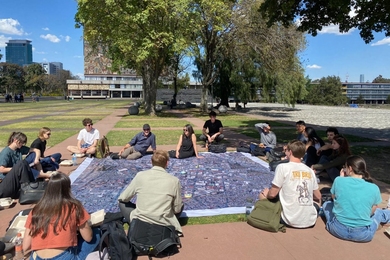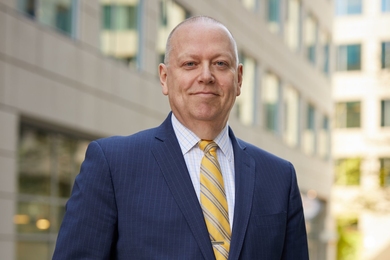CAMBRIDGE, Mass. -- The experiment that made it all happen for the 1998 Nobel Prize in physics took place in 1982 at the Francis Bitter Magnet Laboratory at the Massachusetts Institute of Technology.
The physics prize, which is accompanied by $978,000 to be split among the recipients, will be shared by Robert B. Laughlin of Stanford University, who received a Ph.D. in physics from MIT in 1979; Horst L. St������rmer, who works at Columbia University and Bell Laboratories in Murray Hill, N.J., and Daniel C. Tsui of Princeton University. All three were working at Bell Labs when they began the research that led to this week's prize for discovering how electrons can change behavior. Laughlin subsequently did the theoretical basis for the work at Lawrence Livermore National Laboratory in Livermore, California.
Laughlin attributed his comprehensive understanding of physical phenomena to MIT's strong emphasis on engineering. It was a "confluence of things from engineering that prepared me for understanding the fractional quantum Hall effect and coming up with an explanation," he said during a TV interview at Stanford.
Although the prize did not go to an MIT faculty member, "this is very much an MIT Nobel Prize," said Robert Birgeneau, dean of science and professor of physics, who recalls Laughlin as "a brilliant and charismatic graduate student, very self-confident, strong-willed and outspoken, even at the student stage" of his career. "He was very clear in his own mind that he wanted to pursue fundamental issues in physics.
"His approach was remarkably creative and intuitive. It wasn't that he sat down and slogged away at calculus for five years. He thought deeply about the problem and had a very different way of approaching it," Birgeneau said. MIT physics professor Peter A. Wolff said of Laughlin's theory, "The minute you saw it, you knew it had to be right, but it was a surprise. It was a very profound theoretical thing, but it was based on a very physical phenomenon."
The trio's work is called the fractional quantum Hall effect, based on a 19th century discovery by American Edwin H. Hall. Hall applied a magnetic field perpendicularly to a thin metal plate, causing an electric potential to appear that is perpendicular to both the plate and the magnetic field.
A German physicist, Klaus von Klitzing, delving deeper into the Hall effect in 1980, discovered that when the strength of the magnetic field applied to the plate increased smoothly, the change in electrical potential occurred in steps proportional to integer numbers -- as might be predicted by quantum mechanics. Klitzing won the 1985 Nobel in physics for this phenomenon, called the integer quantum Hall effect.
Taking the Klitzing discovery yet another step, St������rmer and Tsui prepared at Bell Labs the experiment that was ultimately carried out at MIT. They sandwiched extremely thin layers of gallium and arsenic together to create a transistor in which electron movement was restricted to two dimensions instead of three. "They did an experiment in a novel physical regime that had not been studied, and they observed some very unexpected, unusual results," said Laughlin's thesis adviser, John D. Joannopoulos, Francis Wright Davis professor of physics at MIT's Research Laboratory of Electronics. "Then Bob constructed a novel and creative theory to explain this behavior."
To make an experiment like this work, "you have to be an artist working with good materials, as well as a good physicist," Wolff said.
With former magnet lab director Wolff behind them, St������rmer and Tsui competed with other national researchers for funding and time in the heavily used magnet lab. They literally saw the experiment blow up at least once while they worked there.
The three sponsoring institutions -- the magnet lab, Princeton University and Bell Labs -- each contributed $100,000 of the cost, but Wolff, as head of the magnet lab for several years in the 1980s, had to fight for St������rmer and Tsui to get the extra time they needed. The pair continued to do experiments at the lab until around 1995, according to Professor Robert Griffin, current director of the magnet lab.
The lab, which operated on the MIT campus with federal funding for 27 years, drew researchers far beyond MIT to conduct a variety of research needing the world's most powerful magnets. In 1990, the National Science Board designated Florida State University as the site for a new national high magnetic field laboratory. The magnet lab continues to serve MIT and other scientists, but on a more limited scale.
Making the experiment work was an expensive, iffy proposition, Wolff recalled. It necessitated putting together an enormous high-field magnet with very low-temperature equipment. "It was really a gamble. There was only a 50-50 chance it would work," he said. In fact, at one point, "the whole inside of the thing blew up and literally hit the ceiling. They thought they had wrecked the equipment, but it survived and they went on."
The variation of the Hall effect occurs at a temperature of almost absolute zero and in a magnetic field almost one million times as strong as the Earth's. Under those conditions, electrons in the transistor appeared to exhibit electrical charges that occur in thirds of a step, seemingly only one-third of what they should have been.
Laughlin, the theorist of the group, immediately framed an explanation that he later said was wrong. It came to him eventually that the electrons were undergoing what has come to be known as the fractional quantum Hall effect. They were interacting as if they were a fluid, and only looked as though they had been broken into thirds. "When you take the magnetic field away," St������rmer explained at a news conference at Bell Labs Tuesday, "the normal electrons reappear and the one-third fractional electrons disappear.
Experiments on this subject are so fundamental to so much of physics that they have, over the years, generated tens of thousands of papers, Wolff said. Related to high-energy physics, the fractional quantum Hall effect may help scientists understand the quantum structure of the vacuum throughout the space-time of the universe.
Of the three, Wolff knows the German-born and -trained St������rmer best. Wolff tried to hire St������rmer at MIT at least twice, he said, after first meeting him when St������rmer was a postdoc at Bell Labs in the 1970s. "His boss called me up and said, 'Could you come meet this guy and give me an appraisal?' I spent an hour with him and was absolutely blown away. He was super energetic, also tremendously creative." Their relationship continued as at least two of Wolff's students went on to work with St������rmer at Bell Labs. "He's generous, and he was kind of a father to them. When they were taking classes and doing research at Bell Labs one week out of four, they went to his house and were together like a family."
Wolff says St������rmer is outgoing and personable, and recalls Tsui as the more inward-looking of the pair. Tsui spent a few months at MIT as a visiting scientist in 1988.
After taking a class with Joannopoulos in the early 1970s, Laughlin joined his research group from 1975 through 1979, when he completed his thesis on "The Structure and Excitations of Amorphous Solids and Surfaces" -- a topic unrelated to the one for which he won the Nobel Prize.
Laughlin "had spent a few years in the army after graduating from Berkeley, so he came in to graduate school at a more mature level," Joannopoulos said. "He was extremely motivated. My impression is that he had a very strong basic understanding of physics, and that he was very imaginative and creative. So that, combined with his outgoing and outspoken personality, gave me the impression that he was really a unique kind of individual."
From MIT, Laughlin went as a postdoc to Bell Labs, where Joannopoulos said he became intrigued with the quantum Hall effect. "The first thing he did was try to come up with a theory for the integer quantum Hall effect. Bob then moved to Lawrence Livermore National Laboratory. He did his work on his own -- with a loose connection to MIT in that he would talk to me about it off and on -- in a very systematic way. It was a very creative idea and involved brilliant intuition on his part."
Joannopoulos also remembers Laughlin as "always great fun as a graduate student. The group was always laughing and fooling around." Joannopoulos said that a little-known fact about Laughlin is that he is an accomplished pianist and composer. Laughlin has played some of his original concertos when visiting Joannopoulos at home.
Laughlin has had an interesting career, Wolff said. "He's very bright, but he tries crazy things. He used to talk to me about his ideas, and some of them were right off the wall. But he was right when an awful lot of people thought he was talking nonsense."







